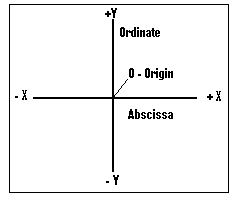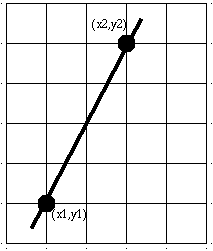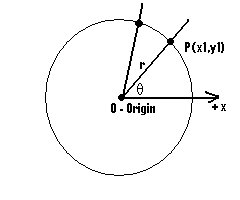Rectangular Coordinates 
Plane is divided into 4 quadrants by 2 perpendicular lines intersecting at the origin point O. The distance from the X axis is the y-coordinate (ordinate) the distance from the Y axis is the x-coordinate (abscissa).
Distance between 2 points 
The distance between two points P1(x1,y1) and P2(x2,y2) is found by using the Pythagorean Theorem:
D = SQRT( (x2-x1)^2 + (y2-y1)^2)
Midpoint of a Line 
The midpoint, M, of a line segment P1(x1,y1) to P2(x2,y2) is given by:
MP = (x,y) = ((x1+x2/2), (y1+y2)/2)
Slope of a line passing through 2 Points 
The slope of a line is defined as the tangent of the angle of inclination. Thus M = TAN(THETA) where
THETA is the angle of inclination and M is the slope. The slope through 2 points is:
M = TAN(ø) = (y2 - y1) / (x2 - x1)
Test for Perpendicular and Parallel Lines
Two lines with slopes M1 and M2 are perpendicular if:
- M1 = -1/M2 or M1 * M2 = -1
- the cosine of the angle between them is 0
Two lines are parallel when their slopes M1 and M2 are equal.
Parametric form of a Line
Given points P1 = (x1,y1) and P2 = (x2,y2), the parametric form for a line is:
x = x1 + t(x2-x1)
y = y1 + t(y2-y1)
0 <= t <= 1
t is called the parameter. When t = 0 we get P1 and when t = 1 we get P2. As t varies
between 0 and 1, we get all the other points on the line
segment between P1 and P2.
Polar Coordinates 
A polar coordinate (in 2 dimensions) is an ordered pair (r, theta) which are defined as follows. For
a point, P, r is the distance from the origin to P. Theta is the angle between the x-axis and the
line segment from P to the origin. Notice that there is more than one valid value for theta. For
example, if the angle between the x-axis and the line segment is 30 degrees, valid values of theta are (in
degrees):
30, (30+360) = 390, (390+360) = 750, etc.
The use of polar (instead of Cartesian) coordinates can simplify some calculations.
Changing Coordinate Systems
Changing from Polar to cartesian coordinates :
x = r × cos(ø), y = r × sin(ø)
Conversely, changing from Cartesian coordiantes to Polar:
r² = x²+ y², ø = arctan(y/x)

